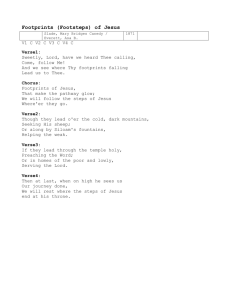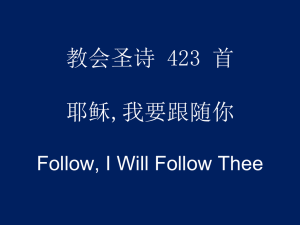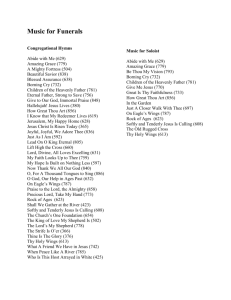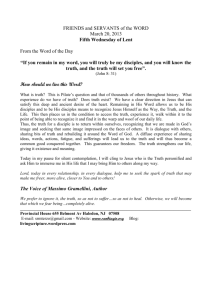lecture outline
advertisement
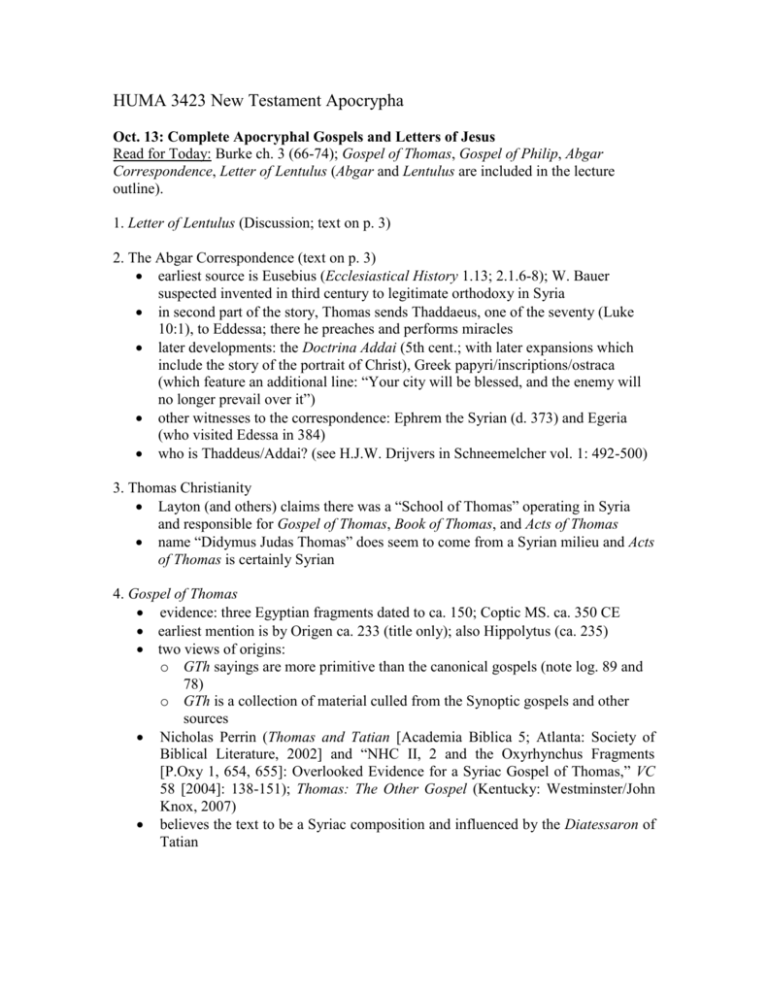
HUMA 3423 New Testament Apocrypha Oct. 13: Complete Apocryphal Gospels and Letters of Jesus Read for Today: Burke ch. 3 (66-74); Gospel of Thomas, Gospel of Philip, Abgar Correspondence, Letter of Lentulus (Abgar and Lentulus are included in the lecture outline). 1. Letter of Lentulus (Discussion; text on p. 3) 2. The Abgar Correspondence (text on p. 3) earliest source is Eusebius (Ecclesiastical History 1.13; 2.1.6-8); W. Bauer suspected invented in third century to legitimate orthodoxy in Syria in second part of the story, Thomas sends Thaddaeus, one of the seventy (Luke 10:1), to Eddessa; there he preaches and performs miracles later developments: the Doctrina Addai (5th cent.; with later expansions which include the story of the portrait of Christ), Greek papyri/inscriptions/ostraca (which feature an additional line: “Your city will be blessed, and the enemy will no longer prevail over it”) other witnesses to the correspondence: Ephrem the Syrian (d. 373) and Egeria (who visited Edessa in 384) who is Thaddeus/Addai? (see H.J.W. Drijvers in Schneemelcher vol. 1: 492-500) 3. Thomas Christianity Layton (and others) claims there was a “School of Thomas” operating in Syria and responsible for Gospel of Thomas, Book of Thomas, and Acts of Thomas name “Didymus Judas Thomas” does seem to come from a Syrian milieu and Acts of Thomas is certainly Syrian 4. Gospel of Thomas evidence: three Egyptian fragments dated to ca. 150; Coptic MS. ca. 350 CE earliest mention is by Origen ca. 233 (title only); also Hippolytus (ca. 235) two views of origins: o GTh sayings are more primitive than the canonical gospels (note log. 89 and 78) o GTh is a collection of material culled from the Synoptic gospels and other sources Nicholas Perrin (Thomas and Tatian [Academia Biblica 5; Atlanta: Society of Biblical Literature, 2002] and “NHC II, 2 and the Oxyrhynchus Fragments [P.Oxy 1, 654, 655]: Overlooked Evidence for a Syriac Gospel of Thomas,” VC 58 [2004]: 138-151); Thomas: The Other Gospel (Kentucky: Westminster/John Knox, 2007) believes the text to be a Syriac composition and influenced by the Diatessaron of Tatian Matt 8:20/Luke 9:50 Foxes have holes and the birds of the air nests, but the son of man has nowhere to lay the head Gos. Thom. 86 Foxes have their holes and ___ birds ____ have their nest, but the son of man has no place to lay his head and rest. Diatessaron Foxes have their holes and ___ birds ____ have their nest, but the son of man has no place to lay his head and rest. intermediary position: layers Pearson: 1. core sayings from mid-first century Jerusalem; associated with James; apocalyptic (e.g. 11, 16, 68, 82, 111) 2. brought to Edessa late first century; becomes more mystical, ascetic, protological 3. Gos. Thom. As we know it now composed ca. 140 4. brought to Egypt and circulated there in second half of second century 5. translated into Coptic sometime in late third century DeConick: a “rolling corpus”: 1. “kernel gospel” ca. 30-50 CE 2. accretions relating to relocation and leadership crises (50-60 CE) 3. accretions relating to Gentiles and early eschatological crises (60-100) 4. other accretions (80-120) Mark Goodacre, Thomas and the Gospels: “missing middles” 5. The Gospel of Philip (excerpts p. 4) date of origin: ca. 200-350 CE perhaps originated in Syria (see Syriac etymologies in pars. 19, 47, 53) variety of literary forms: aphorism, saying, comparison, metaphor, parable, polemic, discourse, etc. sayings of Jesus (see appendix): 17 sayings, nine are citations and interpretations of Jesus’ words from the canonical gospels The Abgar Letter (Eusebius, Ecclesiastical History 1.13) A copy of a letter written by Abgarus the toparch to Jesus, and sent to him by means of Ananias the runner, to Jerusalem. Abgarus Uchama the toparch to Jesus the good Saviour that hath appeared in the parts (place) of Jerusalem, greeting. I have heard concerning thee and thy cures, that they are done of thee without drugs or herbs: for, as the report goes, thou makest blind men to see again, lame to walk, and cleansest lepers, and castest out unclean spirits and devils, and those that are afflicted with long sickness thou healest, and raisest the dead. . And having heard all this of thee, I had determined one of two things, either that thou art God come down from heaven, and so doest these things or art a Son of God that doest these things. Therefore now have I written and entreated thee to trouble thyself to come to me and heal the affliction which I have. or indeed I have heard that the Jews even murmur against thee and wish to do thee hurt. And I have a very little city but (and) comely (reverend), which is sufficient for us both. The answer, written by Jesus, sent by Ananias the runner to Abgarus the toparch. Blessed art thou that hast believed in me, not having seen me. For it is written concerning me that they that have seen me shall not believe in me, and that they that have not seen me shall believe and live. But concerning that which thou hast written to me, to come unto thee; it must needs be that I fulfil all things for the which I was sent here, and after fulfilling them should then be taken up unto him that sent me. And when I am taken up, I will send thee one of my disciples, to heal thine affliction and give life to thee and them that are with thee. The Letter of Lentulus Lentulus, to the Senate and the Roman People, greetings. There has appeared in these times, and, indeed, is still living, a man of great power named Christ Jesus, who is said by the Gentiles to be the prophet of truth, but his disciples call him the Son of God. He raises the dead and heals all diseases. He is a man of average size and pleasing appearance, having a countenance that commands respect, which those who behold may love or fear. He has hair the color of an unripe hazelnut, smooth almost to the ears, but below his ears curling and rather darker and more shining, hanging over his shoulders, and having a parting in the middle of his head according to the fashion of the Nazarenes. His brow is smooth and quite serene; his face is without wrinkle or blemish, and a slight ruddiness makes it handsome. No fault can be found with his nose and mouth; he has a full beard of the color of his hair, not long but divided in two at the chin. His facial expression is guileless and mature; his eyes are greyish and clear. In his rebukes he is terrible, but in his admonitions he is gentle and kind; he is cheerful, but always maintains his dignity. At times he has wept, but he has never laughed. In stature he is tall and erect and his hands and arms are fine to behold. His speech is grave, reserved, and temperate, so that he is rightly called by the prophet, “Fairer than the sons of men.” Sayings of Jesus from the Gospel of Philip Based on http://jacksonsnyder.com/sss/pages/Gospel%20of%20Philip.htm (16) The Lord said to the disciples, “[…] from every house. Gather (things) into the father’s house; but do not steal and remove (anything) while in the father’s house.” (24) He said that day in prayer of thanksgiving, “O you who have joined the perfect light with the holy spirit, join the angels with us, too, as images.” (30) A disciple asked Jesus to give him something belonging to the world. Jesus told him, “Ask your mother and she will see that you have someone else’s things.” (47) Jesus went into Levi’s dye works. He took seventy-two different colors and mixed them in a vat. Afterward, the cloth in the vat came out all white. “Even so, the Son of Man has come as one who dyes,” he said. (48) The Wisdom who is called barren wisdom is the mother [of the] angels. And the companion of the […] Mary Magdalene. The […loved] her more than [all] the disciples, [and he used to kiss her on her […more] often than the rest of the [disciples] […]. They said to him, “Why do you love Mary [Magdalene] more than any of us?” The Savior answered them, “Why don’t I love you as much as I love her? Who said that I loved her? When a sighted person goes into a dark place with a blind person, they are both blind. When the light comes, the one who sees perceives it, but the blind man remains in darkness. The truth is that you are blind.” (57) The Lord said: “Blessed is he who is before he came into being. For he who is, both came into being and shall be.” (61) “Some say that there is a heavenly man and one even above him. They call the former ‘the lower one’ and the latter, who knows all hidden things, ‘the upper one.’ This type of thinking is wrong. It would be more accurate for them to say, ‘There is the inner and there is the outer. Then there is the one outside the outer.’ For example, the mouthpieces of the Lord called the place of destruction ‘the outer darkness’ because there is no other greater darkness. Likewise, we pray to the ‘outer one,’ (known as the Father, ‘the one who is in secret’), from inside our own secret places. Yet, the Father, being the outer, is among us all at the same time and is the fullness of deity. So the Father is the one who they mean when they say, ‘The man above.’” (69) “I came to make all things new, as things above are new, and to make the outside things like the inside. I came to bring these things together in one place.” (84) “Some have entered the kingdom of heaven laughing, and have left laughing, as well.”

